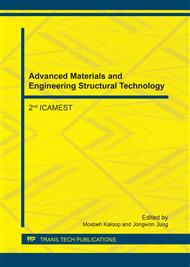[1]
K. Bando, K. Sakano, Y. Noguchi, Y. Shimizu, Development of high-bright and pure-white LED lamps, J. Light Visual Environm. 22 (1998) 2-5.
DOI: 10.2150/jlve.22.1_2
Google Scholar
[2]
K. Sakuma, N. Hirosaki, R. Xie, J. Lumin, Red shift of emission wavelength caused by reabsorption mechanism of europium activated Ca-a-SiAlON ceramic 126, (2007) 843-852.
DOI: 10.1016/j.jlumin.2006.12.006
Google Scholar
[3]
X. Teng, Y. Liu, Y. Liu, H. Yunsheng, H. He, W. Zhuang, J. Rare Earth, 27, Preparation and luminescence properties of the red-emitting phosphor (Sr1–xCax)2Si5N8: Eu2+ with different Sr/Ca ratios, 27 (2009) 58-61.
DOI: 10.1016/s1002-0721(08)60191-x
Google Scholar
[4]
J. W. H. van Krevel, J. W. T. van Rutten, H. Mandal, H. T. Hintzen, R. Metselaar, Luminescence Properties of Terbium-, Cerium-, or Europium-Doped α-Sialon Materials, J. Sol. State. Chem. 165 (2002) 19-24.
DOI: 10.1006/jssc.2001.9484
Google Scholar
[5]
K. Sakuma, K. Omichi, N. Kimura, M. Ohashi, D. Takana, N. Hirosaki, Y. Yamanoto, R. J. Xie, T. Suehiro, Warm-white light-emitting diode with yellowish orange SiAlON ceramic phosphor, Opt. Lett. 29, (2004) 2001-(2003).
DOI: 10.1364/ol.29.002001
Google Scholar
[6]
H. A. Höppe, Angrew, Recent Developments in the Field of Inorganic Phosphors, Chem. Int. Ed. 48, (2009) 3572-3582.
DOI: 10.1002/anie.200804005
Google Scholar
[7]
C. Feldmann, T. Jüstel, C. Ronda, Inorganic Luminescent Materials: 100 Years of Research and Application, Adv. Funct. Mater. 13, (2003) 511-516.
DOI: 10.1002/adfm.200301005
Google Scholar
[8]
Y. S. Hu, W. D. Zhuang, H. Q. Ye, S. S. Zhang, Y. Fang, X. W. Huang, J. Lumin. Preparation and luminescent properties of (Ca1-x, Srx)S: Eu2+ red-emitting phosphor for white LED, 111 (2005) 139-145.
DOI: 10.1016/j.jlumin.2004.07.005
Google Scholar
[9]
D. D. Jia, X. J. Wang, Alkali earth sulfide phosphors doped with Eu2+ and Ce3+ for LEDs, Opt. Mater. 30, (2007) 375-379.
DOI: 10.1016/j.optmat.2006.11.061
Google Scholar
[10]
X. H. He, Y. Zhu, Improvement of morphology and luminescence of CaS: Eu2+ red-emitting phosphor particles via carbon-containing additive strategy, J. Mater. Sci. 43, (2008) 1515-1519.
DOI: 10.1007/s10853-007-2359-2
Google Scholar
[11]
E. J. W. Verway, E. L. Heilmann, Physical properties and cation arrangement of oxides with spinel structures, J. Chem. Phys. 15 (1947) 174-180.
DOI: 10.1063/1.1746464
Google Scholar
[12]
J. Rowland, J. S. Yoo, K. -H. Kim, R. E. Hummel, and P. Holloway, The Stability of Y3Al5O12 : Ce, ZnS: CuAl, Y2O2S : Eu, and (Sr0. 98Ba0. 02 ) 2SiO4 : Eu under UV Irradiation, Electrochem. Solid-State Lett. 2005 8(4): H36-H38.
DOI: 10.1149/1.1861897
Google Scholar


